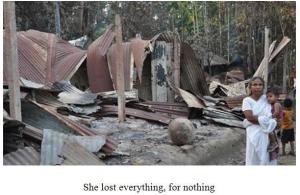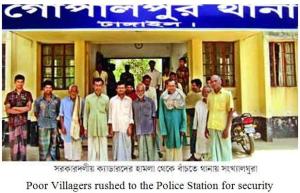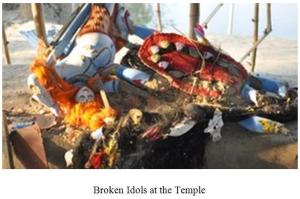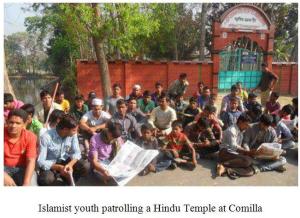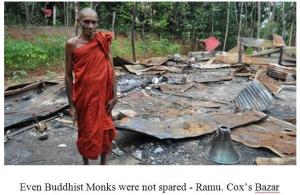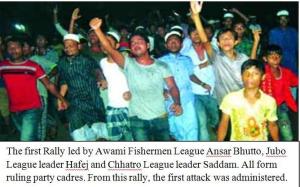Whether we like to admit it or not, Minority repression has become a very common feature in Bangladesh. Though constitutionally Islam is the state religion for so long until the 15th amendment, Muslim, Hindus, Christians and Buddhist are living in peace and harmony for thousand years in here. However, there are some incidents where members of those Minority communities are subjected to political or personal vilification or even mere scapegoats for political purposes, for which they have to pay price with their lives and property. This paper will analyze the recent issues on Minority repression and the masterminds behind them.
Introduction
Witnessing the most unprecedented violence and rising death tolls in her own history since 1971, Bangladesh is now facing yet another very sensitive socio-political problem on Minority Protections. Just after the death sentence passed on Islamist opposition leader Mawlana Delwar Hossain Sayedee by the International Crimes Tribunal, the most fatal violence spread out throughout whole Bangladesh over the course of weeks. Apart from death of more than 150 peoples along with some members of Security forces, the losses of the Non-Muslim Minority community have become evident again. However, there has been claim and counter claim about who is to blame for those and what they have done, but the misery and helplessness of those few people have crossed all the limits, they have become yet again being used as political scapegoats. 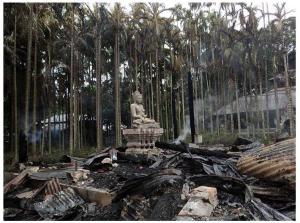
The Opposition camps of BNP and Jamaat claim that supporters have been the subject of inhuman police brutality as they exercised their democratic right to protest the verdict of Mawlana Sayedee. More than hundred activists are been shot dead, remaining thousands critically wounded. Mass arrests are also been a regular practice of Police throughout Bangladesh. However, ruling Awami League and its fourteen party alliances denied such claims, rather it propagated by its supporters in the press and media that the opposition and its supporters have attacked the minority Hindu community. The government and government leaning media have in unison pointed the finger at the opposition in general, and at Jamaat in particular.
No matter what, the fact is nearly a thousand minority houses and around 50 temples are reported to have been attacked throughout the whole country. Houses and businesses of the minorities were burnt in Chittagong, Rajshahi, Khulna, Barisal, Noakhali, Gaibandha, Rangpur, Sylhet, Thakurgaon, Bagerhat and Chapainawabganj. The most severe forms of violence were reported at South Chittagong, where the protest and clashes with the Security forces were also intense.
Historical Context – Issues of Minority in Bangladeshi Politics
Minorities, most notably the Hindu and Buddhist communities had always been subjected to political victimization in Bangladesh. The political culture depicts Awami League, the present ruling party of Bangladesh as the savior and patron of those minority communities. Since 1971, when the Pakistan Army started their armed campaign against Hindu minorities, Awami League being the only pro-liberation political party then, was the last resort of minority communities. On the contrary, BNP and especially Jamaat (which is been described by many as a radical Islamist party with extreme communal hatred) are thought as the key people behind all violence against them. However, this ‘myth’ of Awami League being the Protectors of Minority Community had been shattered in many ways in last four years, most notably is the events of last few days as well.
The 2010 annual report of Odhikar, a Bangladeshi Human Rights NGO, records the deaths of six members of the minority community and injury of 384. In a later report on 2011, Odhikar records that on January 13 2011, following violence in the Jhenaidah, Hindu shops came under attack from Awami activists and 20 people were injured. One explanation for this was that the activists thought the Hindus of the town did not cast their vote in favor of their candidate!
In 2012 the attacks grew more frequent, with actions not just attributed to ordinary party members but high ranking officials of the Awami League, its student wing (Chhatra League) and its youth wing (Jubo League), with the collusion of security and local administrative officials. Many of these incidents have been reported in the mass media.
A cursory analysis of the incidents of anti-minority violence in the last year, as evidenced on the website Desh Rights, paints a disturbing picture for the future of Bangladesh. It clearly shows how Govt. Party men are attacking minorities for their own benefits. These are not attacks occurring in the middle of the night by hooded assailants, but in broad daylight by recognized figures in the community. What is perhaps even more troubling is that despite how well documented these attacks are, they are yet to prompt members of the political and intellectual elite to challenge the government.
Recent Violence on Minorities – A Few Case Studies
After the judgment passed on by the Tribunal on 28th February, violence spread out all over the Country and at the same time, attacks on minority properties and religious institutions had also began. Among many other places, Bashkhali in South Chittagong was the more intense place where a big number of Hindu residences, temples and shops were destroyed. Attacks by masked assailants and sneak attacks also took place on Noakhali, Laxmipur, Gaibandha and Bagherhat. A short brief on the incidents there will clarify everything.
Case 01 – Bashkhali, Chittagong
Just after the judgment passed, thousands of people came down to the streets and start protesting. They passed by the marketplace which is mainly a Hindu inhabited area, but nothing happened then, as admitted by a Vivekananda Maharaz, head Sevait of the local temple. After that, some masked man came and dowsed some Hindu houses into fire. They also attacked the temple, looted the valuables and then ran away. Six houses were burnt to the ground, and the Loknath Temple was destroyed as well. Local people wonders why they didn’t get police attention at all, when the attacked temple was adjacent to the Police Camp? Locals said, the assailant waited for about two hours, till the fire burnt down everything but no one came into their aid. Again, sources said that Abdullah Liton, leader of the local Awami League faction was seen instigating people to attack the minorities. More interestingly, none of the houses or shops of Hindu people who are active supporters of the ruling party were attacked at all! Such unanswered questions created a very uncomfortable situation back there. Yet, that AL leader Liton is seen collecting money for helping the minorities and if anyone refuses, he is been threatened to be victimized as an accused in the cases filed by the Police. However, Police, Local Govt. and the Local ruling party leaders including Liton blatantly pointed fingers to Jamaat; but the actual scenario at the locality says different.
Five cases is been filed regarding this violence, which caused a loss of about Tk 20 Lacs and more. Besides, Harinath Sheel, a senior member of the minority community died on this violence. A High Court division bench issued a Suo-Motu order to arrest all perpetrators within seven days, but in reality the case is still circulating into the political blame games.
Case 02 – Gopalpur, Tangail
Helpless people from Minority Hindu community seek shelter at the Police station to save their lives and property from ruling Awami League cadres at Gopalpur, Tangail. Despite of being beaten and getting their house destroyed several times, these people still tried hold fast to their birthplace but now, things went out of limits.
In a written petition, Ranglal Chanda, leader of the local Hindu community stated that, local thugs were forcefully collecting money from them for a long time, but this time, on Saturday (9th March) they demanded tk Fifty Thousand within ten hours, otherwise the families would be banished from the village and females of their family would be abducted and ravished. This helpless people rushed to the Police Station for help, and there is a little hope for them as all the thugs committing such atrocity belongs to Awami League, the party which those aggrieved people thought to believe as their protector and savior for time beings.
Case 03 – Bagherhat
A woman of Kachua in Bagerhat went into hiding after the upazila chairman, Sheikh Mahfuzur Rahman, reportedly raped her, asked her to leave the country and threatened her not to seek justice. Mahfuzur Rahman is the convener of the Kachua unit Awami League, is reported to have raped the woman in her house at night on December 19 at Charkati in the upazila. Her husband, who owns a pharmacy, was not at home at the time.
Local people alleged that Mahfuzur Rahman had threatened lives of her and her husband if they did not leave the country. The woman, along with her husband and a minor son, went into hiding early December 21. Muktijoddha Sangsad and Puja Udjapan Parishad of the district went on demonstrations, rallying for the removal of Mahfuzur as upazila chairman and his early arrest.
The police officer-in-charge, GG Biswas told that he had already been asked to take legal action after an investigation and file a case against the accused. ‘But I am yet to find the victim as she is reported to have gone into hiding after the upazila chairman threatened her life,’ he said. This indicates that the perpetrator isn’t supposed to be punished, as they woman and her family might have been gone away from the country.
Besides, a widely used Temple was blazed on fire by some unknown thugs at Morelganj, Bagherhat. They came silently at night and then ran away after setting the fire. Loca Police official stated that they’re trying to find out the culprits. However, the ‘usual suspects’ – the local leaders of Jamaat strongly condemned such brutal act and denied any liability whatsoever.
The scenario is almost the same in other places of Bangladesh as well. Temples and houses of minority Hindu community are being attacked at night, and then the liability is given on the shoulders of Jamaat and other Islamist groups.
Apart from that, some collections of blogs clearly show that all those attacks in the Hindu communities are run by Awami League and party cadres in last few years. Another collection of the newspaper clippings is a vivid illustration of the tortures and atrocities committed by Awami League and other thugs, which are on rise day by day.
Who’s behind the scenes? A Critical Analysis
One has to question Jamaat’s capacity to organize a nationwide and well-coordinated attack against minorities. The organizational capacity of Jamaat has been under sustained attack for well over three years. Local offices have been closed; regional leaders and organizing cadres have been monitored and arrested in a systematic manner.
In a recent editorial at Amar Desh, Shanjib Choudhury, a member of Hindu minority argued that it is highly unlikely that the party, already accused of being ‘communal’ in their politics, would not engage in something so foolish as this at a time when they are being persecuted themselves and under serious scrutiny. The organization has gone out of its way to issue press statements, contest media reports and urge people to protect the Hindu and other minority communities. Jamaat also, have officially denied any sort of involvement in tortures on Minorities and demanded Judicial Investigation. In some places, student org Islami Chhatrashibir was seen to patrolling Hindu temples to protest it from violence.
However, the evidence available does not just point to the opposition, but also to the doors of the Awami League government, which is also been discussed in our analysis. No matter what, Government has failed its basic duty of upholding the peace and protecting lives and properties of its citizens, but as a political party too it has had an active hand in persecuting minorities. Even some Minority organizations directly blamed Govt. for its failure to protect them, and in many cases protecting the offenders who attacked them.
To keep a critical eye, it is worthwhile examining the Awami League’s record on minorities in light of recent experiences of its violent practices cynically leverage communal tensions for electoral, economic and personal gains.
Recent Experiences: A Memory from Ramu
Just a few months back, a brutal attack on minority Buddhist community by some unknown assailants shocked the whole country. Hundred years’ old monastery and Buddhist temples were blazed, most of the valuables including gold and stone statues of Gautama Buddha were looted. Poor Buddhists became homeless overnight after thousands of terrorists and thugs rampaged through villages, looting houses and burning down Buddhist temples. “There were people from all the major political parties among the rioters – some were local leaders who are well-known to us” – according to a Buddhist community leader. Local people say the violence went on for nearly six hours in various villages of the Ramu sub-division.
The protests were triggered after an image allegedly insulting the Quran was posted on the Facebook wall of a Buddhist youth. Investigations by local media later revealed the youth had nothing to do with the incident. Although some try to link the attacks on Buddhists with the ethnic conflict between Rohingya Muslims and the majority Buddhist population in the neighboring Burmese state of Rakhine, local people dismiss the notion. “Our neighbours were also involved in the attacks. So the government should take measures to make the local Muslim community show tolerance. Only that will bring a permanent solution and prevent such events in the future,” said Nilutpal Barua, a teacher.
However, digging deep on the crisis situation, it was found that the first protest rally against the unconfirmed post on Facebook insulting Quran, was brought out and headed by local Awami League leaders. Later on, they organized and instigated the mass people to attack on the Buddhist villages. More surprisingly, police and Administration authorities did not take any action against this rampage which continues for about 5-6 hours. This also indicates some involvement or tacit approval from the Govt. to its local flagmen. But no wonder, a number of syndicated media and Awami party men immediately started to blame Jamaat and BNP for this violence and some cases were also been filed against them.
Where is the Solution?
As intended, this charge has gained traction in the international media, spread fear amongst minorities and fired up many in the pro government camp with moral indignation. Nevertheless the ruling Awami League and its allies have given such protestations short shrift, and have benefitted in projecting their opposition as fundamentally opposed to the rights and dignity of Bangladesh’s religious minorities. This strategy has been a historically profitable one, but one that recent evidence confounds. But as long as the question of equality and Human rights comes into existence, it poses a big question to the Democratic situation of Bangladesh. As the Govt. must protect its every citizen irrespective of religion, cast, colors, the Minorities of Bangladesh must be given preferences and their security must be ensure at the first hand. Political parties of Bangladesh must come out of their traditional outlook towards the 10% population of Bangladesh; their lives and properties must not be used for cheap political gain-loss anymore.
But to solve the problem it is only the State and Govt. that can do that. Here are some recommendations –
- First thing required is the rule of law and order. God does not need human law to exist or a country to survive but a State and its inhabitants do.
- A problem is not made in a day. This is a problem, which we have been exposed to as long as we can remember. Reason it persists: it has never been addressed properly or evil forces have taken over when some good soul was trying to address it. Addressing the education system is also a requirement and should be devoid of religious inclination.
- Strengthening the Political institutions and maintaining accountability and internal democracy is also crucial.State and judiciary should be neutral in their judgment; police and law enforcement agencies should play their role as mere law enforcement agencies. Many cases we discussed here before, they do not register cases or give twists and spins to the incidence under influences from invisible forces. These invisible forces have to be made accountable. Govt. is the guardian and protector for every human being but if it turns against its own people, where would they go?

